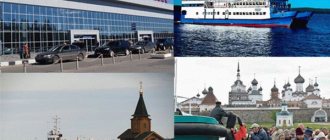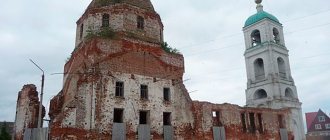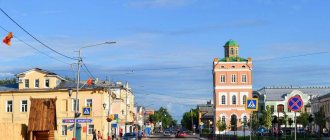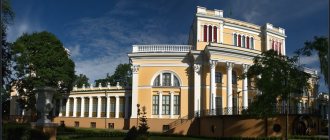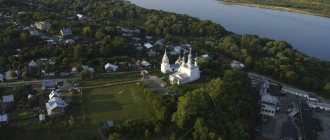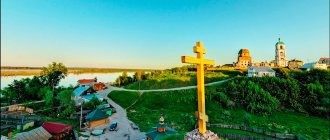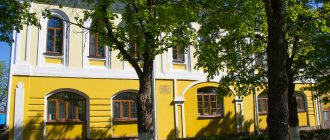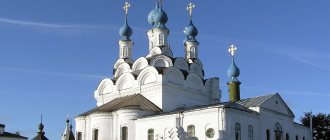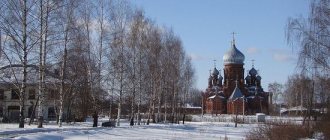Murom is a city of contrasts and the architecture of Murom is proof of this. Everything is intertwined in it: the provincialism of small streets and the classicism of architectural monuments of antiquity, the pagan essence and the religious-Christian atmosphere, neglect and prosperity, fact and fiction...
Probably every resident of the metropolis has at least once dreamed of hiding from the usual bustle in a secluded place, where life flows smoothly and the soul rests. So, Murom is just such a corner of Russian beauty and originality. Maxim Gorky also wrote: “Whoever has not seen Murom from the Oka has not seen Russian beauty.”
And that's true! Contrary to the established opinion that the main attractions of Murom are the ancient monasteries, its main and immense attraction is the Oka, carrying its streams under the steep cliff of the city. Its water expanses spread freely and widely. It’s rare where you find such peace and beauty, beckoning, calling you to put aside all your affairs and stay here in Murom.
Monument to Ilya Muromets
- 3.1 Nikolo-Embankment Church
- 4.1 Water tower
Monument to Ilya Muromets
The monumental history of Murom begins right from the banks of the Oka River. If you stand on the Oka embankment and look up at the city, then among the green crowns of trees and many-sided church domes, a colossal monument to the Russian epic hero Ilya Muromets stands out. Standing with a sword raised to the heavens, he, as if the only defender of the city, protects Murom and the Murom people.
Murom monasteries
A significant layer of the architecture of Murom, its religious and cult buildings are ancient monasteries and churches, which have preserved the history of not only the city, but also the entire Russian land. On the territory of Murom, four monasteries are still alive today: Spaso-Preobrazhensky, Resurrection, Holy Trinity and Blagoveshchensky.
Spaso-Preobrazhensky Monastery
Monument to Ilya Muromets
The oldest of them, the Spaso-Preobrazhensky Monastery, was founded on the site of the fortified courtyard of Prince Gleb Vladimirovich no later than 1015. But the first chronicle mention of him, found in the Tale of Bygone Years, dates back to 1096. By the way, this was the first monastery on the territory of Rus'. It was located not on the territory of ancient Murom, but 12 kilometers from it, since the Vedic faith of the Slavs was strong in those days. Its foundation was forced. The people of Murom stood firmly for their faith and opposed Christianity in every possible way.
The Spassky Monastery served for a long time as a defensive outpost of Rus'. Nowadays the monastery operates. Buildings from the 16th and 17th centuries have been preserved on its territory: the Transfiguration Cathedral (founded in 1552) and the Church of the Intercession (1691).
Resurrection Monastery
Resurrection Monastery
Also interesting may be the buildings of the Resurrection Convent, founded in the 16th century on the site of the country residence of the patrons of family love and fidelity, Peter and Fevronia. On the holiday of their veneration - July 8, newlyweds from all over the country come to Murom to receive the blessing of the ancient lovers.
Annunciation Monastery
Annunciation Monastery
It is famous for the fact that it was founded by Ivan the Terrible after a victorious military campaign against Kazan in 1553 on the site of the first city wooden church of Murom. The monastery has been subjected to extensive destruction throughout its history and has been preserved in a distorted form. The oldest building on the territory of the Annunciation Monastery is the Annunciation Cathedral (founded in 1553).
Holy Trinity Convent
Holy Trinity Convent
The latest of the entire monastery quartet. The exact date of its foundation is not known. It is only known that it was founded in the second quarter of the 17th century. This monastery ensemble is not ordinary. The most beautiful thing about it is the glazed tiles of the 17th century with a wide variety of patterns and forged gilded crosses - the height of creativity of the Murom masters of the 17th century. The most ancient building of the Holy Trinity Monastery is the Holy Trinity stone cathedral, built in 1643, which has survived to this day.
Murom Hotels
The choice of hotels in Murom is much wider than in Elabuga and Yelets. Booking.com offers more than 30 accommodation options. The boss spent the night in Murom several times and, alas, has negative experience with Murom hotels. We warn readers against the Lada and Kremlevskaya hotels.
I will do a detailed analysis of the Murom hotels a little later. Here are only links with a minimum of comments.
Three heroes - 2,500 per night in a double room without breakfast. Breakfast - 300 rubles per person. Rating - 9.4!
Choose a room at the Three Bogatyrs hotel
Merchant's yard - 2,900 - 3,200 for a two-room apartment, breakfast at the same price, 300 rubles per person. The rating is slightly lower - 8.7. Perhaps because it's more expensive. After all, as soon as the price rises, so do expectations and requirements.
Choose a room in the retro hotel "Kupechesky Dvor"
AMOSOV - a bit far from the center. The best rating is 9.7! But very budget-friendly - from 1,700 to 2,500 for triple occupancy.
Choose a room at the AMOSOV hotel
I will not claim that I have fully covered the topic of Murom sights. Much is left beyond the scope of the article. We will be sincerely grateful to readers for additions and advice to travelers who included the ancient Russian city of Murom in their route.
Churches
Of the religious architectural monuments, I would also like to mention two churches - the Nikolo-Embankment Church of Kosma and Damian (in common parlance Kosmodamianskaya).
Nikolo-Embankment Church
Nikolo-Embankment Church
The first of them is the Nikolo-Embankment Church, its second name is “Nikola the Wet”. This name is explained by the fact that the temple stands at the very bank of the river and during floods the water's edge passes almost to the church walls. From the Oka you can clearly see the domes of “Nikola the Mokroy”, intricately reflected in the fast waters. Intertwined with the green crowns of trees, the domes of the church from the times of Peter the Great invite you to put aside your business and land on the shores of the ancient city of Murom.
Church of Cosmas and Damian
Church of Cosmas and Damian
The second, the Church of Cosmas and Damian, is notable for its antiquity and legendary history of construction. It was built on the orders of Ivan the Terrible in 1565. The legend says that before the campaign against Kazan, the Russian Tsar stopped in Murom, where he earnestly prayed to the saints for the success of the campaign. And upon its successful completion he promised to build several stone churches in the Murom lands. The campaign, as we know, was successful, and the promise was fulfilled in full.
Today, the tented Kosmodamian Church has lost its original appearance, but, nevertheless, stands proudly in the middle of a changing world and pleases the inquisitive gaze of many tourists.
On this solemn note, I will probably finish the description of the Christian shrines of Murom. After all, there are still so many interesting things ahead: a water tower, shopping arcades, various city schools, houses of famous personalities, a printing house and much more.
Civil architecture of Murom
Water tower
Water tower
Amazing architectural monument of Murom. The water tower was opened on August 26, 1864. The history of its construction is very interesting. The construction of a water pipeline in Murom was sponsored by the famous philanthropist and wealthy merchant Alexey Vasilyevich Ermakov. He brought to life a project of free water supply for all citizens. Free use of the water supply and a ban on leasing the water tower premises were the only conditions for sponsoring an important city project. This is how the first water supply system in the entire Vladimir province appeared.
Shopping arcades
Shopping arcades
The shopping arcades were built in 1816. The classicism of the building, in addition to graceful arches and powerful columns, still creates the flavor of a 19th-century shopping area. Vaulted cellars were built under the galleries of the shopping arcades, where grain was previously stored.
The shopping arcades stood for almost 200 years with almost no repairs. This is eloquent evidence of the skill of the workers of the century before last, who built conscientiously. To this day, the shopping arcades are still used for their intended purpose. Directly behind them is the city market.
Printing house building
Printing house building
The building of the Murom printing house is a wooden one-story structure. It was modestly decorated. All its external wealth is carved platbands on the high windows.
Initially, this cozy and somewhat naive house was not built for the city printing house. From 1862 to 1912, the usual measured life of a prosperous family of a well-known city lawyer and son of the city’s head, S.V. Rusakov and his wife L.E. Shestakova, took place there.
After the revolution, starting on December 15, 1918, a printing house was located in Rusakov’s house. It has been publishing various newspapers and forms for over 90 years. And her story continues today. Naturally, this is not the first printing house in Murom. The first printing house was opened by merchant S.P. Gundobin back in 1869. It was located in the estate of the Zvorykin merchants, on Torgovaya Square, but its building has not survived to this day.
Women's gymnasium building
Women's gymnasium building
The Murom women's gymnasium appeared thanks to the efforts of the city mayor, A.V. Ermakov, in 1860. This was a very privileged place of study, since upon completion, the students could continue their education in higher educational institutions. After 34 years (in 1894-1896), a new two-story red brick building, with bright, spacious classrooms and large windows, was built for the gymnasium. The appearance of the building is, first of all, its carved cornices, full of romance and balustrades.
Today the building has been completely preserved. Its long history remembers not only the school years, but also the war times, during which it housed a hospital. An educational institution with an initial humanitarian focus, designed mainly for the training and graduation of teachers, has retained its direction in our time. Today, the Murom Pedagogical College is located in the building of the Murom Women's Gymnasium.
Real school building
Women's gymnasium building
The building of the real school was built according to the design of currently unknown architects. The project sent from Moscow was original, not related to standard buildings. To confirm this, it was presented at the Paris World Exhibition in 1878. The opening of the real school was facilitated by the eminent Muromets, who has a voice in the city duma - F.D. Zvorykin.
The construction of a school with a craft and technical focus became possible thanks to the charter of real schools issued on May 15, 1872, which allowed the construction of their own secondary educational institutions with a technical focus in cities throughout Russia. The original location of the school was the merchant house of Karatygin. And in 1876-1889, a beautiful two-story building made of red brick was erected for the school.
On the ground floor, in the western and eastern wings, there were apartments for the director and inspector of the real school. The second floor was occupied by offices and experimental classes for various purposes. The appearance of the building is very unique and interesting. The building has two porches, and its facades are decorated with decorative white inserts and cornices.
What is quite noteworthy is that the institution paid scholarships to talented but not wealthy students. And in some cases, even for food and clothing for their pupils.
In 1906, the Murom Real School released from its walls the future great inventor and father of television - V.K. Zvorykina. A representative of one of the most famous families in Murom.
House of the Karatygin merchants
House of the Karatygin merchants
The house of the Karatygin merchants, designed in the Empire style, was built in 1837. The original owner of the house was a wealthy merchant of the first guild G.A. Shvedov. But due to the death of the head of the family, the Shvedov family became poorer. And in 1962, the magnificently beautiful mansion was bought by the Karatygin family, famous in Murom.
It is known that the mansion was for rent. Between 1875 and 1880 it housed a real school. By 1890, the descendants of Karatygin Sr. decided to sell the old house. The mansion has been practically neglected; it has become very dilapidated, with little left of its former luxury.
Today, having made your way through the dense thickets, you can still see the former features of the luxurious decoration of the merchant family nest, but in general its condition is very, very alarming.
Moore through the years. Part 2.
Moore through the years. Part 1
Let's continue to recognize, admire and compare Moore in photographs. This time our path will be more winding and long, but no less exciting. I have prepared a map of our promenade. The navigator says that the route will take 1 hour, and we will cover 4 km. So, off we go?
Route
Today we will start our walk from the beginning of one of the main streets of the city - Lenin Street. Before the revolution - Rozhdestvenskaya, it took its name from the temple located in close proximity - the Cathedral of the Nativity of Christ. During Soviet times, the street was named in honor of Vladimir Ilyich Lenin.
Shtapsky Bridge, st. Lenina (Rozhdestvenskaya)
Shtapsky Bridge is located at the beginning of the street. From the twin houses it is thrown across the Assumption Brook. The bridge was built in 1948 in connection with the construction of the Trud stadium. In Soviet times, all holiday demonstrations began from here.
The name of the bridge was given by the area to which it leads - Shtap. In 1764, by decree of Catherine II, retired military officers and disabled guards were sent to Murom. They settled behind the Uspensky (formerly Georgievsky) stream. The newly formed suburb was given the name Headquarters. Over time, the letter “B” in the word “Headquarters” was replaced by a more dull “P”.
Shtapsky Bridge 1955-1956/2020
Shtapsky Bridge 1962/2020
House of merchant Konstantinov / “Home Goods” store, st. Kommunisticheskaya 1 (Ivanovskaya)
In the 19th century, the house belonged to the merchant of the second guild, Alexander Nikolaevich Konstantinov. People's Artist of the USSR Pyotr Aleksandrovich Konstantinov was born and spent his youth in this house. After graduating from the Murom Real School in 1917, he left for Moscow. Over fifty years of creative activity, he played 400 roles. He served most of his career in the Soviet Army Theater and the Maly Theater.
During Soviet times, this mansion housed an atelier, now a “Home Goods” store.
1974/2020
Pyotr Alexandrovich Konstantinov
Church of the Beheading of John the Baptist / School No. 3, st. Lenina, 18 (Rozhdestvenskaya)
The church stood on the corner of Rozhdestvenskaya (Lenin) and Ivanovskaya (Kommunisticheskaya) streets. First mentioned in 1574. The church was rebuilt and moved several times. The first stone church was built in 1806, dismantled in 1866, and rebuilt by 1874. In 1913, a temperance society was solemnly opened in Murom, the chairman of which was elected the founder of the society, the priest of the Baptist Church, Peter F. Trelin. The church was closed in the 1920s. Demolished in the second half of the 30s.
In 1964, a school was built on the site of the temple.
1900/2020
1971-1972/2020
Square named after A.V. Ermakova
In 2012, the grand opening of the renovated square and the new bust of A.V. took place. Ermakova. Alexey Vasilyevich served as mayor from 1862 to 1869. For 6 years, he invested a lot of effort and money in the improvement of Murom. During the period of his local government, a water supply system was built (the first in the Vladimir region!), a theater was erected, an orphanage was opened, an almshouse was expanded, a hospital and a city library were established, the fire brigade was reformed, the central streets and squares were paved, the Spassky Congress was organized, from the Assumption ravine Residents were evicted and transferred beyond the Uspensky ravine to a new urban settlement on the field, New Headquarters.
1901-1902/2020
Water tower
Having become the head of local government, A.V. Ermakov first of all made every effort to install a water supply system in the city, which was necessary for the townspeople. There were wells in the courtyards in a few courtyards; all the other Murom residents went to the river for water along steep and undeveloped ramps. In 1863, engineer E.I. was appointed to develop the water supply system. Erzhemsky. On August 26, 1964, the grand opening of the water supply system took place (More details about the history of the Murom water supply system).
1900s/2020
House of merchant Sokolov, st. Lenina 17 (Rozhdestvenskaya)
House of merchant Zubchaninov, st. Lenina 19 (Rozhdestvenskaya)
House of merchant Sokolov. The 19th century house belonged to the trading house “Ivan Sokolov with Sons” in the early 1900s. There were seven shops selling a wide variety of goods here.
The house next door to Sokolov belonged to the merchant Zubchaninov. Its first owner was Nazariy Ivanovich. After 1914, the second floor of the building was transferred to the Murom noble and merchant meeting for holding gala evenings there.
2000s/2020
Cinema "October"
The cinema building was built in the 50s of the twentieth century. In 2006, reconstruction was carried out, and the cinema reopened for city residents.
1982/2020
Library / Cultural and entertainment center "Empire"
The characteristic house of the 19th century, the last owners of which were the Zvorykins-Averyanovs, is now the Imperia cultural and entertainment center. Since 1919, the building housed the city central library. Initially, the owners of the cultural center planned to give the center a different name in order to preserve old traditions - “Library”.
This is where part of the photo walk along Rozhdestvenskaya (Lenin) Street ends, and we move towards the Spaso-Preobrazhensky Monastery.
1974 / 2022
Spaso-Preobrazhensky Monastery
Spassky Monastery is the oldest Orthodox monastery in Russia (only the Kiev Pechersk Lavra is older, but it is located on the territory of Ukraine). The date of its foundation is not precisely known. It is believed that it was founded by Prince Gleb (the first Russian saint, the son of the Baptist of Rus' Vladimir Krasno Solnyshko). The monastery was first mentioned in the “Tale of Bygone Years” in 1096 in connection with the death of Prince Izyaslav (Murom prince, son of Vladimir Monomakh) in Murom.
The first stone cathedral on the territory of the monastery was erected by decree of Ivan the Terrible in 1565.
In 1918, the Spassky Monastery was closed on charges of propaganda against the Soviet regime. In 1925 it was transferred to the local history museum, and in 1927 it was leased to the 41st Infantry Regiment. Since 1929, the monastery has been occupied by the military and the NKVD department. The military unit was located on the territory until 1995. In one of the cathedrals of the Spaso-Preobrazhensky Monastery, a particle of the relics of St. Ilya Muromets.
Spaso-Preobrazhensky Cathedral 1987 / 2022 (Photo DO Dobrynkin N.G.)
beginning of the twentieth century / 2022
From the Spaso-Preobrazhensky Monastery along the multifaceted Gubkin Street (formerly Kozmodemyansky Lane or Bogatyreva Gora), we continue our walk to the Smolensk Church (you can read more about Gubkin Street and the houses on it).
Smolensk Church
Initially, like most churches in Murom, the church was wooden. It received its name from the icon of the Smolensk Mother of God. In 1804, after a fire, a stone church was erected. In 1868, icons from the destroyed Kozmodemyansk church were transferred to the church. Having become the successor of the ancient temple, the church received a second name - Novo-Kozmodemyanskaya.
The church was closed in 1930 and was used as a warehouse in the 40s-60s. From 1977 to 1995, the museum’s exhibition hall was located in the temple. In 1995, the church was returned to the Russian Orthodox Church.
1900 / 2022
Two Kozmodemyansk churches: old and new, are connected by a staircase along which we go down.
Kozmodemyansk Church
According to one legend, the church was built on the site of Ivan the Terrible’s camp tent. During the third (victorious) campaign against Kazan, he caught a bad cold and, after recovery, gave an order to build a church in the name of the healers Kozma and Demyan.
According to historical documents, it is known that the temple was erected with the money of the townspeople.
A unique architectural feature of the temple was a tall twelve-meter tent with thirty-two sides. In 1868, this stone tent collapsed, and for almost 150 years the church stood with a nondescript flat cover instead of a roof. In 2010, a metal tent was built, close in shape to the original one, but inferior to it in height and elegance.
1960-1970 / 2022
Along the embankment, along the Oka River, our path lies to the Church of St. Nicholas of the Naberezhny. But let's also look at the old pontoon bridge and what the Kremlin Mountain used to look like.
Pontoon bridge
The wooden bridge used to cross to the other side appeared in the 50s of the 20th century. The bridge began work in May and stood until frosts in November, and went to the Nizhny Novgorod region for the winter. In the 80s, the wooden bridge was replaced by a metal one. During the cold season, ferries transported vehicles and people.
After the construction of a new cable-stayed bridge in 2009, the need for a pontoon bridge disappeared. And he was sold as unnecessary to the city of Pavlovo, where he currently serves. The only reminders remained were the concrete piers on both banks.
1962 / 2022
2000s/2022
Kremlin Mountain (View of Oksky Park)
The mountain is called Kremlevskaya because the city’s Kremlin was located on it for several centuries. In the Kremlin, after the annexation of Murom to the Moscow Principality, a governor lived, hence the second name of the mountain - Voevodskaya (more about the Kremlin and Oka Park).
year unknown / 2022
Nikolo-Embankment Church
The Nikolo-Embankment Church was first mentioned in 1574. The temple received its name in honor of St. Nicholas the Wonderworker. It was built in accordance with the ancient tradition of building St. Nicholas churches near the water, since St. Nicholas the Wonderworker was revered by the people as the savior of drowning people and the patron saint of sailors and travelers.
Initially, the church was wooden, and in 1700 construction of a stone temple began. It is interesting that the new temple was erected at a time when Peter I banned stone buildings everywhere except St. Petersburg. The shortage of bricks and masons gave rise to this ban, the violation of which was strictly punished.
Apparently because of this, the construction of the temple lasted for 17 years. The work was carried out at the expense of the Moscow priest Dmitry Khristoforov, whose father previously served in the St. Nicholas Embankment Church.
1890-1900 / 2022 (Photo BEFORE I.P. Myazdrikov)
1980s/2022
From the Church of St. Nicholas Naberezhny along Plekhanov (Troitskaya) street we reach the turn to Timiryazev (Blagoveshchenskaya) street, where we immediately have a view of the ruins of an old mansion.
House of merchant Karatygin, st. Timiryazeva 3 (formerly Blagoveshchenskaya Street)
Karatygin's house is one of the best examples of residential building architecture of the first half of the 19th century.
In 1837 merchant T.A. Shvedov is building a house on Blagoveshchenskaya Street. After his death, his sons were ruined, and in 1862 the building came into the possession of the merchant M.A. Karatygina. Maintaining the mansion was expensive, and Karatygin rented out the premises. So, in 1873, officer quarters for an infantry battalion were located there. In 1875-1880 – Murom Real School. In 1881 (after the death of the merchant), the house was rented to the headquarters of the 13th Narva Hussar Regiment. At the same time, a veterinary shelter and a trumpet team are located there. In 1890, the house was bought by the Murom zemstvo and used to house the headquarters and 2nd company of the infantry battalion. In March 1917, the house was occupied by the Murom Council of Workers' and Soldiers' Deputies. In November 1917, Soviet power in the city was proclaimed within the walls of this building. In the summer of 1918, participants in the anti-Soviet uprising in Murom were shot in the basement of a house. From the 30s to the 80s, the house was given over to communal apartments.
Now the building is in disrepair and almost destroyed.
1960s/2022
Along Timiryazev (Blagoveshchenskaya) street we go to the monastery, which gave this street its old name.
Holy Annunciation Monastery, st. Krasnoarmeyskaya (formerly Uspenskaya St.)
The founding of the Annunciation Monastery is connected with the history of the adoption of Christianity in Murom. The Murom people professed paganism for a long time, while Prince Vladimir baptized Rus' back in 988.
Due to the fact that worldly names are used in the chronicle, and spiritual names are used in the life, confusion occurs, and the opinions of historians differ. Saint Prince Konstantin (baptismal name) is recognized as the Baptist of Murom. We know him only from his life, he is not mentioned in the chronicles. The main version is that Konstantin is Yaroslav Svyatoslavovich, the grandson of Yaroslav the Wise (1070s - 1129). At the same time, many sources mention that the baptism of Murom took place in 1196, which could not have happened under Yaroslav Svyatoslavovich.
Before us is another mystery of the history of our Murom - baptism occurred a century earlier or was Konstantin not Yaroslav Svyatoslavovich?
According to the life, Prince Konstantin, together with his wife Irina, sons Mikhailov and Fedor, arrived in Murom to convert the local residents to Christianity. Local pagans killed Michael's son, not wanting to accept either the prince or Christianity. Subsequently, struck by the sign from the icon of the Mother of God, they repented and were baptized in the waters of Lake Kstovo. In memory of the death of his son, Constantine erected the wooden Church of the Annunciation of the Blessed Virgin Mary, where he buried his son. Over time, the entire princely family rested at the walls of the temple. The relics of the holy princes rest there to this day.
The monastery was founded on the site of the Annunciation Church according to the vow of Ivan the Terrible, after his campaign against Kazan in 1552.
The monastery was closed in 1919. The monks lived in the city, but continued to serve in the temple. In 1940, the cathedral was closed, but only for 2 years. Until 1991, the Annunciation Church remained the only one operating in Murom.
View of the Annunciation Monastery 1950s / 2022 (Photo by DO Spassky S.A.)
1990s/2022 (Photo DO D. Kazakov)
1890s/2022 (Photo DO Dobrynkin N.G.)
Holy Trinity Convent, pl. Peasant (formerly Trinity Square or Konnaya)
Saint Prince Constantine erected another wooden church next to the Annunciation Church in the name of Boris and Gleb. Subsequently, a wooden Trinity Church was built on this site. In 1643, a brick monastery was founded by the Murom merchant Bogdan Tsvetnoy. A unique feature of the Trinity Cathedral are tiles that cannot be found on other churches in Murom.
In 1918, workers settled in buildings on the territory of the monastery. In 1921, the monastery was closed, and its territory became a “working town.” The monastery housed various warehouses, machines and a knitting production cooperative. After the war, the cell buildings began to serve as communal apartments.
In 1991, the monastery was returned to the Russian Orthodox Church. The main shrine of the monastery is the relics of the holy saints Prince Peter and Princess Fevronia.
Trinity Cathedral 1910s / 2022
Trinity Monastery. North Gate 1970s/2022
Entrance to the bell tower of the Trinity Monastery 1930s/2020.
The second part of the photo walk around Murom ends. Today, through time, we found ourselves on the streets of Rozhdestvenskaya, Troitskaya, Blagoveshchenskaya, in Kozmodemyansky Lane and on the embankment of the Oka River. Next time we will go for a walk along Moskovskaya Street - the main street of the city and one of the few that has retained its historical name.
